sierraclub.org - sierra magazine - september/october 2010 - planting seeds
In New York's urban core, pastoral dreams take root
By Tali Woodward
Unique Harris turns the sprig of basil over between his fingers. He takes a sniff, pops it into his mouth, chews for a few seconds, then flashes a thumbs-up to the rest of the kids gathered in Brook Park, a community garden in the South Bronx. Unique has a goal: to taste every vegetable, herb, and fruit on offer.
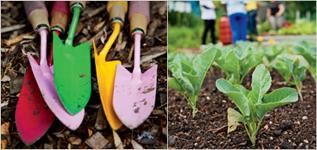 A rainbow of trowels awaits the grip of middle school gardeners at Brook Park in the Bronx.| Sara Stathas
A rainbow of trowels awaits the grip of middle school gardeners at Brook Park in the Bronx.| Sara Stathas"I'm daring and I like food," he boasts, before backing down a bit: "I just like food, that's all." The eighth grader wants to be a football player. But if that doesn't pan out, he hopes to build a career as a chef. He already acts as a sous-chef when his father, who makes dishes inspired by the cuisine of his native Trinidad, cooks for their family of 13. Unique uses every opportunity he can to get creative in the kitchen. "If I make macaroni and cheese, I put a little more oomph in itparsley, oregano, dabs of hot sauce," he says.
This summer, Unique intends to eat his way across New York City. He doesn't have any particular foods in his sights, but if you doubt his adventuresome spirit, he's happy to tell you about the time he tried barbecued iguana meat in his uncle's Brooklyn backyard: "It tasted disgusting because he left the skin on."
In this part of the Bronx, fast food dominates the landscape. You can smell something deep-fried and sweet from inside the nearby Brook Avenue subway station, and there's a McDonald's next to the exit. Around the corner, a produce market sells droopy celery, bruised eggplant, and tomatoes that are more pink than red.
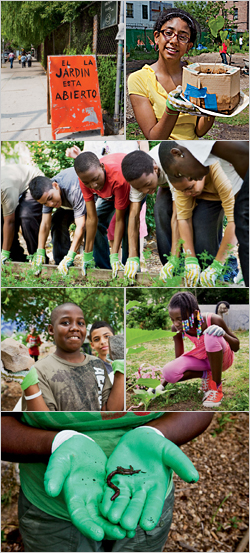 A sign announces that Brook Park garden is open
to students who want to introduce seedlings, repair raised beds, haul rocks, weed crops, or hunt worms.| Sara Stathas
A sign announces that Brook Park garden is open
to students who want to introduce seedlings, repair raised beds, haul rocks, weed crops, or hunt worms.| Sara StathasFor Unique, the Brook Park garden offers a chance to experience food right off the vine. Today he'll sample mint, strawberries, and kale.
Some of the other kids don't care as much about the garden's produce; they're more interested in the beehive in the corner, the thrill of spending a summer day in the sun, the chance to do something for the community. All 30 of themsixth, seventh, and eighth graders at P.S. 214, the Lorraine Hansberry Academyare taking part in an environmental-education program called Into the Woods, which supplements classroom activities with 10 outdoor expeditions. They gush about climbing Bear Mountain, canoeing down the Bronx River (where several of them took accidental dips), and observing the small plants here in Brook Parkwhere their journey began two and a half months earlier.
"We wanted to remind them that they can find green space in their community," says Vanessa Tricoche, director of Into the Woods, which is part of a larger after-school program run by Morningside Center for Teaching Social Responsibility. The center has always tried to generate respect for nature, but this year, with a grant from the Sierra Club's Building Bridges to the Outdoors program, it launched an environmental curriculum at P.S. 214.
As the students gather for an informal graduation ceremony in the garden, it's obvious that they've grown familiar with the leafy surroundings. But each of them seems to be taking away something differenta conquered fear, a newfound skill, a dream more clearly focused.
Harry Bubbins is the director of Friends of Brook Park, which was formed shortly after he and others started working to revitalize the park in 1999. Bubbins tells the kids, "Before that, the only things here were weeds, pit bull fighting, and people selling things because they didn't have jobs." Some of the kids nod solemnly. They're familiar with the history shared by many of New York City's community gardens, which were festering urban sores until local residents did the hard work to turn them into small oases of green (see "Homegrown," page 51).
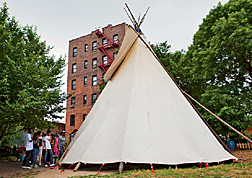 A temporary teepee provides a shady place to cool down.| Sara Stathas
A temporary teepee provides a shady place to cool down.| Sara StathasThis garden is bigger than mosttaking up almost a third of a blockand is occupied by plants and trees, a small gardener's shed, and, today, a tall white teepee. Ornamentals are sprinkled about, but most of the flora is edible: cilantro, squash, arugula, peas, parsley, and cabbage. The crops are arranged in small plots tended by local families or community groups.
At Bubbins's urging, the students remove the wooden frames around a plot to use in other parts of the garden. They gently separate the wood from the earth inside. Once the frame is free, they lift it high and carefully carry it away, replacing it with large rocks collected from across the garden. They're so bouncy and enthusiastic you'd think they were being timedor at least vying for a prize. They call out to one another or to the adults, announcing each accomplishment. After finishing a plot, they take a moment to admire their work.
David Veliz has spent years working in New York City's community gardens, first with the nonprofit Green Guerillas and the city's Parks and Recreation Department, now as a Sierra Club organizer. Watching the kids with pride, he says, "Community gardens are one of the best ways to get people excited about sharing."
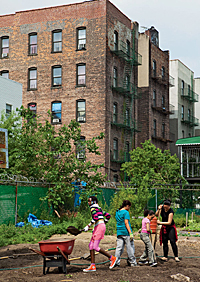 Students work up a sweat shoveling dirt into a waiting wheelbarrow.| Sara Stathas
Students work up a sweat shoveling dirt into a waiting wheelbarrow.| Sara StathasThe race is on to replace the border on another plot. Two girls find a cart and fill it with rocks. Two more join the project, and they finish in record time.
Eighth graders Tykeah Priester and Jenea Singleton, close friends since sixth grade, have enjoyed spending time in Brook Park, but unlike Unique, they haven't always enjoyed the produce. The weirdest thing they sampled was an herb called stevia, which is often used as a sweetener.
"It was a shock," Jenea says of the leaves' intense sweetness.
When they recount their experiences with Into the Woods, the details escape in a torrent.
"We did hikes to Blue Mountain, Bear Mountain, and the peninsula by Orchard Beach," Tykeah says. "We did experiments on the [Bronx River] to see if it was clean or dirty."
Tykeah says the trip to Bear Mountain was the most difficult expedition. "It was really high, and there were lots of rocks. But it was interesting, when we got to the top, to see the view." Now, she says, "I definitely want to try Bear Mountain again. I'm scared of heights, but I want to do it again."
Into the Woods has changed her attitude toward the outdoors. "Before the program, I wouldn't want to go hiking or anything," she says, adding, as though it's obvious, "because of the bugs."
By lunchtime, most of the kids are taking a break from the 90-degree heat. They hang out on benches under trees or douse themselves with water from the garden hose.
Over by the entrance, Christopher Ocasico still has his hands in the dirt. He remembers gardening once before, when he was in second grade. "But I would consider this my first experience," he says, with a maturity that matches his bookish glasses. "It's actually fun. I like dealing with plants and nature. I like to see plants prosper." He pauses and then, in case it's not evident, spells it out: "Places like this make me enthusiastic."
Christopher lives two blocks from his school, where, he says, there are "plenty of trees, but not many small plants." He's interested to see how crops grow and what they need to live. "I have several hobbies," he explains. "Observing wildlife and nature is one of them."
Unsurprisingly, Christopher likes science a lot. This year he's studying physics. "It's not that hard," he says. "You just have to think about it for a bit." He's considering becoming an archaeologist, but in the meantime he's also learning about the stars.
Vanessa Tricoche says that she and the other adults connected with Into the Woods hope to keep all the students enrolled next year and to add another 30 spots. They had more applications than openings this year and were forced to resort to a lottery.
Fortunately for Christopher, they'll also expand the curriculum to include astronomy. "We did a poll to ask who had seen the stars and only two kids had," Tricoche says. "They were both recent immigrants from Africa."
TALI WOODWARD is a freelance writer and an adjunct professor at the Columbia University Graduate School of Journalism.
This article was funded by the Sierra Club's Building Bridges to the Outdoors project, whose goal is to give every child in the United States an outdoor experience.
HOMEGROWN
From compact truck farms to artsy green space, community gardens reflect neighborhood culture
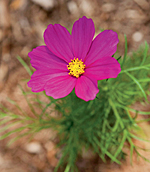 Sara Stathas
Sara StathasSusan Greenfield has been gardening at El Sol Brillante, in the East Village, for 30 years. When she moved into an apartment next to it, the area now occupied by peach and fig trees was an abandoned lot that she describes as "a war zone." The first garden plots established here were locked inside metal cages to prevent looting.
"Gradually, the cages came down," Greenfield says, noting that the final remaining barrier was dismantled last summer. It's a trajectory typical of New York City's 500 community gardens, many of which took root in the vacant lots of the 1970s and 1980s and continue to provide sanctuary from the concrete and pollution of the city in a diverse range of neighborhoods.
Even in this part of Manhattan, where you can hardly walk two blocks without passing a community garden, you'd be hard-pressed to find something quite like El Sol Brillante. An intricate wrought iron fence surrounds the verdant landscape, where white butterflies flit among weeping willows. In the rear sits a compost operation that's churned out 340 gallons of nutrient-rich fertilizer over the past eight months. The garden is filled with shouts and giggles from an adjacent playground and children's garden, which had been abandoned two years ago. Greenfield and some of the other 50 members of El Sol Brillante contacted local parents, and together they transformed it into a place for kids to learn about horticulture.
Just down 12th Street, Campos Garden is nearly as green as El Sol Brillante, but smaller and quieter. Walk three blocks south and you'll find La Plaza Culturalan entirely different kind of garden. It functions partly as an open-air art space, with a gigantic stone amphitheater and a decorative border made of old cans.
Community gardens are also common in Central Brooklyn, the Bronx, and East Harlem, where they often serve as centers of cultural celebration. A small green space on 119th Street near Second Avenue in East Harlem is known informally as "Papo's Garden," in honor of Rafael Marrero, the neighborhood activist who nurtured it, and who died last year. His legacy lives on through the children's gardening programs, the shaded seating area for seniors, and the fresh produce for the community. Throughout, it's festooned with Puerto Rican flags, plastic windmills, and stuffed animals. Nearby, Carver Garden has six picnic tables and a gazebo packed with chairs. People from two support centers for the developmentally disabled are among its frequent tillers.
Mostbut not allof these city plots grow food, and the crops often reflect the residents' ethnic backgrounds. "If you go to a garden that's Puerto Rican, you'll find a lot of beans, tomatoes, and jalapenos and other peppers," says Lenny Librizzi, who's been working at community gardens on behalf of the nonprofit GrowNYC for two decades. "In gardens with Asian gardeners, you'll find bok choy." At Phoenix Garden, in Brooklyn's Bedford-Stuyvesant section, workers harvest nearly 2,000 pounds of vegetables during growing season.
Broader efforts to boost environmentalism are common in the gardens. Many, like El Sol Brillante, operate composting programs and offer free workshops on the practice. In a Bushwick garden, residents have developed an EcoStation to serve as a nexus of environmental education. In Clinton Hill, the Hollenback community garden operates a solar-powered composting toilet. Librizzi has helped install rainwater-harvesting systems at more than 60 sites.
"Each garden is unique," he says. "There is no cookie-cutter here." Nearly all function as outdoor community centers, providing a spot for parties, gatherings of local artists, and community organizing. "What they all have in common," says Librizzi, "is a group of committed volunteers who have agreed to work on building and sustaining a communityno matter how tough it gets."
Such gardens also boost real estate values, suggests a 2006 New York University study. "A community garden has a statistically significant positive impact on residential properties within 1,000 feet," notes the study, "and the impact increases over time."
Despite their multiple functions and passionate support, community gardens have not always had government backing. Starting in 1998, Mayor Rudy Giuliani ordered workers to begin razing gardens on city-owned land to make way for development. About 20 were bulldozed or consolidated before the city agreed to settle a lawsuit in 2002. The agreement preserved about 300 sites but targeted another 150 for demise.
That deal expires in mid-September, and it's not clear what will take its place. Gardeners are already lobbying officials to extend and fortify municipal protection. "There may have been 700 to 800 gardens [in New York City] at some point, so we have lost a substantial number," says Hannah Risley-White from Green Guerillas. She estimates that only 10 or so new gardens have taken root since the Giuliani years.
Risley-White and others hope the city will make it easier to create new gardens, as well as adopt a clear procedure for those that fall into disrepairone that would give locals a better chance to save them. —T.W.